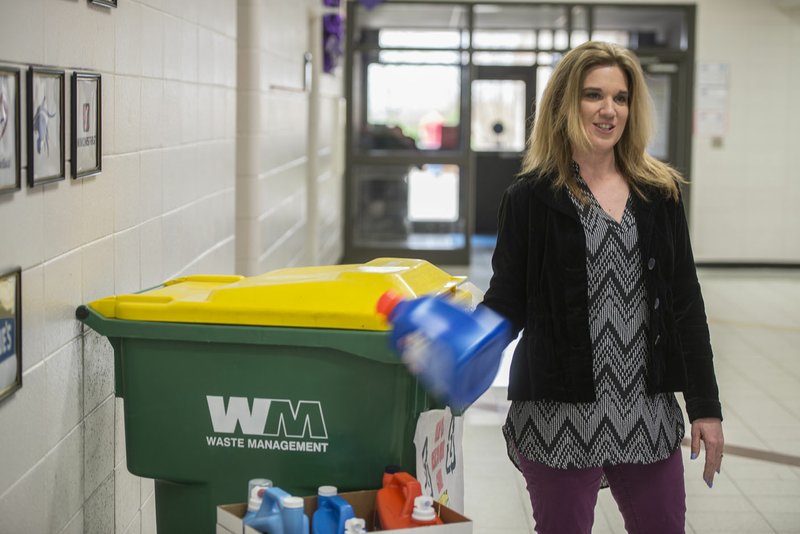The elementary schools sit 11 miles apart, one in Fayetteville and the other in Springdale.
They are similar in size and perform similarly academically. Both are eligible for federal money for the high populations of low-income children they serve.
Title I, Part A
• A section of the Elementary and Secondary Education Act, most recently reauthorized as the Every Student Succeeds Act.
• Provides financial assistance for school districts and its campuses with high numbers of children from low-income families to help ensure all children meet challenging academic standards set by states.
• Allocated through four formulas giving weight to school districts with greater percentages of children from low-income families.
• School districts are expected to give priority for Title I money to campuses with greatest percentages of children from low-income families.
• In 2009-10, the most recent data for the U.S. Department of Education, more than 56,000 public schools across the country used Title I money to provide additional academic support and learning opportunities to more than 21 million children.
Source: U.S. Department of Education
Northwest Arkansas Title I programs for 2016-17
• Bentonville School District: 23 percent of students in poverty, $1,423,357 in Title I money for 11 schools; eight non-Title I schools
• Fayetteville School District: 40 percent of students in poverty, $1,938,630 in Title I money for eight schools; seven non-Title I schools
• Rogers School District: 59 percent of students in poverty, $3,123,613 in Title I money for 13 schools; nine non-Title I schools
• Springdale School District: 70.8 percent of students in poverty, $5,540,182 in Title I money for 21 schools; eight non-Title I schools
Source: Staff report
But they are part of different school districts with a wide gap in the percentages of children from low-income families attending their schools.
In Arkansas, it's up to school districts to determine how to divide Title I money among campuses, with priority given to campuses with the greatest needs, officials said. Some campuses eligible for money aren't Title I schools.
Recently released estimates from the Arkansas Department of Education show close to two-thirds of the 19 public school districts and charter schools in Northwest Arkansas are expected to receive less Title I money next school year.
In the Fayetteville School District, where 40 percent of children are from low-income families, Happy Hollow Elementary School is a Title I school with a poverty rate of 42.6 percent.
In the neighboring Springdale School District, where 70.8 percent of children are from low-income families, Walker Elementary School isn't a Title I school even though it's eligible with a poverty rate of 55 percent.
Both districts direct Title I money to campuses at or above each district's poverty level, officials said. Poverty rates in schools are determined by the percentages of children who are eligible for free or reduced-price lunches.
All Title I campuses in the Springdale School District have poverty rates greater than 70 percent. Springdale School District this school year received $5.5 million in Title I money that went to 21 campuses where 72 to 98 percent of their students are from low-income families.
Fayetteville School District divided $1.9 million in Title I money among its seven campuses with school-wide programs this school year. The only campus with greater than 70 percent poverty is Asbell Elementary School, with a low-income student population of 81.8 percent.
How Title I money works
Each year, the U.S. Department of Education sends Title I money to the Arkansas Department of Education to distribute to school districts across the state, said Greg Rogers, assistant commissioner of the department's Division of Fiscal and Administrative Services. State officials follow a formula for allocations to school districts, but the pot of money to distribute to schools has been steady at $150 million to $160 million annually for several years.
Regulations for Title I for next school year are in flux and uncertain with the U.S. Department of Education's transition to the Every Student Succeeds Act under President Donald Trump's administration.
The state department's Federal Programs Unit approves each school and district budget and provides assistance, said Jayne Green, Title I director. The department encourages campuses and districts to base Title I spending on student needs.
It's up to school districts to decide which schools will receive Title I money, though there are some guidelines, said Kimberly Glass, federal programs coordinator for Springdale School District. Federal Title I money first must go to campuses where 75 percent or more of their enrollment is comprised of children from low-income families.
After that, school districts have options in how they identify and fund other schools, including ranking campuses by poverty or providing money to certain grade spans, such as elementary schools, Glass said. Schools with a 35 percent to 40 percent poverty rate are eligible to offer targeted programs focused on students identified for services. Schools with at least a 40 percent poverty rate can offer school-wide programs.
All Title I campuses in Springdale provide school-wide programs, she said.
Across the state, schoolwide Title I programs are offered in 749 schools and targeted programs are offered in 69 schools, according to the Arkansas Department of Education. Of the 238 schools with no Title I money, 181 are eligible to participate but are not funded, according to the department.
Other than designating new Title I schools that have opened with levels of poverty at or above the district's poverty level, the Springdale School District only added Title I campuses when it received significantly more money, Glass said. Additional Title I money that came with the American Recovery and Reinvestment Act of 2009 allowed the district in the 2009-10 to designate J.O. Kelly and Helen Tyson middle schools, George Junior High and Springdale High School as Title I schools.
This year, the 21 Title I campuses each received about $500 per child that qualified for free or reduced-price lunches, Glass said. Stretching the district's allocation among the other seven campuses eligible for the money would reduce allocations to existing Title I campuses to about $400 per pupil. Title I money would be spread among 28 campuses instead of 21 campuses, she said.
"When we open up a school as Title I or determine we want to fund an additional Title I school, it doesn't give us more Title I money," Glass said. "It just divides it among more schools."
Different resources
Happy Hollow Elementary received a Title I allocation of $76,200 this school year, Principal Dondi Frisinger said. About $45,000 helps pay for four classroom aides, with the rest going toward teacher training, parent events, and technology and resources for teachers to use in classrooms, she said.
Frisinger was principal at Walker Elementary, where she worked for 15 years prior to joining Happy Hollow. She and her former Walker staff watched over the years as the poverty rate inched toward 50 percent, a level they thought would lead to Title I money for the school, Frisinger said.
They learned last school year the program wouldn't expand to include Walker, she said.
"That was a disappointment for our faculty," she said.
The staff never talked about how they would use Title I money because Walker didn't have that resource, but they did have the support of the campus Parent Teacher Association, some grants and community partners, Frisinger said.
"When you do have kids that are in poverty, you want them to have the same resources or opportunities," Frisinger said at Happy Hollow last week. "That's the challenge -- figuring out how to make that happen."
Students at Walker started a food pantry this school year, Walker Principal Lynn Ryan said. The school continues to benefit from supplemental state money provided by the district, the Parent Teacher Association, grants and contributions from more than 30 community and business partners.
"I feel very strongly that are kids needs are being met," Ryan said. "We maximize every bit of funding we do have and are thankful and blessed to get the funds to support kids' needs."
Splitting the money
The Bentonville School District has 23.2 percent of its students coming from low-income families, said Christy Jay, director of federal programs. Even though the poverty rate is far less than a district like Springdale, Bentonville schools are working to meet the needs of more than 3,800 children from low-income families.
"There are some very needy families and students that live in our School District that very much deserve the same kind of time and attention from a program like Title I," Jay said.
The district this school year received $1.4 million in Title I money. Some Bentonville schools have Title I money for programs that focus on low-income students, while other schools have school-wide programs, Jay said.
The money goes to a mix of elementary, middle and junior high schools in amounts that range from $500 to $900 per pupil, Jay said. The poverty level at those schools ranges from 29 percent to 39 percent. The district's new Creekside Middle School is planned to open as a Title I school, Jay said.
Rogers School District has Title I programs in 13 of the district's 15 elementary schools with proportions of students in poverty greater than 51 percent, said Monica Avery, federal programs director. About 59 percent of the district's students are from low-income families.
Most of the money, $3.1 million this school year, goes toward salaries for staff members on campuses who help train teachers and assist with encouraging parent involvement in schools, Avery said. What's left goes to material and supplies.
Rogers provides more supplemental money it receives from the state for its middle schools and high schools to meet needs of low-income children and to have the support of literacy and math facilitators, Avery said.
Fayetteville School District directs Title I money toward eight campuses with greater poverty than 40 percent, said Mark Oesterle, who oversees federal programs. Ramay Middle School was the last school to become a Title I school in Fayetteville, he said.
"As a district we've seen that number increase somewhat steadily over the last five years," Oesterle said.
Oesterle anticipates a revision in the district's process for dividing up Title I funding for next school year, he said.
The greatest needs
Schools with the highest concentrations of children from low-income families have greater needs than schools with lower levels of poverty, Glass said.
"You don't want to strip high poverty schools of programs and services," Glass said.
With 98 percent of students at Jones Elementary in Springdale coming from low-income families, Principal Melissa Fink assumes every child is at risk for failing academically, she said.
"At any time their home life can change," she said.
Struggles within a child's family affects the child at school, Fink said. In some cases, children have developed gaps in their learning because of frequent moves.
Fink's Title I money amounted to $264,218 this school year, money that went toward salaries for two instructional facilitators and one instructional assistant, she said. They support teachers and provide interventions for struggling students.
Title I money also supports a parent university program meeting on Tuesday evenings and includes a light dinner snack and child care, Fink said. The program provides classes for parents on topics, such as Internet safety, financial literacy, gang awareness and pathways to graduation.
"We're wanting to equip parents and give them the tools they need to make better informed decisions for their children," she said.
Any changes in funding would affect Fink's ability to expand the parent university program, she said. The classes help many immigrant families better understand the American education system and concepts such as earning credits for graduation.
A common question Glass hears is about why the district doesn't fund schools once their low-income population reaches 50 percent, she said.
"That's not the district average any more," she said.
When Glass joined Springdale School District about 10 years ago, about 50 percent of the district's students were from low-income families. Title I money went to about a dozen elementary schools. The district's average has increased and so has the number of Title I schools. Title I money now goes to some middle and junior high schools and Springdale High School.
For campuses, such as Walker, that don't receive Title I money, the district provides extra support with state money paid to districts to supplement programs for students most at risk of not meeting state academic standards, Glass said. Community partners also support programs in those campuses.
Supplemental state money the district provides allows Walker to have additional staff to support students in learning to read and to coach and train teachers, Ryan said.
Educators work within the money they have to determine the greatest needs among students and how to best spend the money to meet those needs, Frisinger said.
When campuses don't have Title I money, they rely on the support of their school districts, Frisinger said. Title I money gives campuses more discretion of how that money is spent within their buildings.
"We always look at kids as kids," she said. "We want to help where we can."
NW News on 04/02/2017


